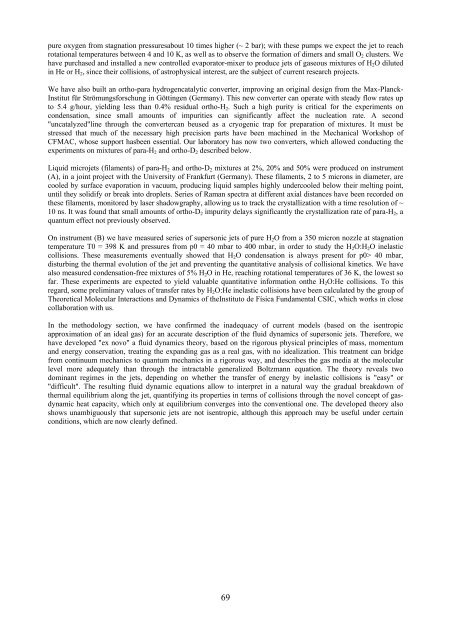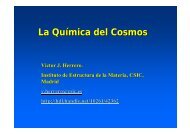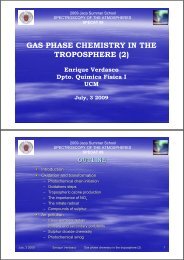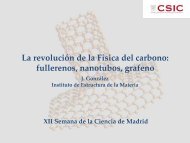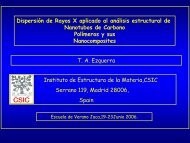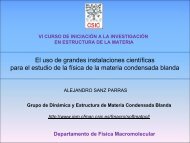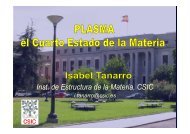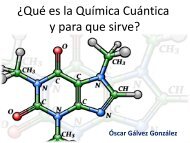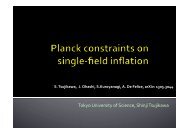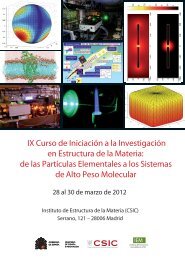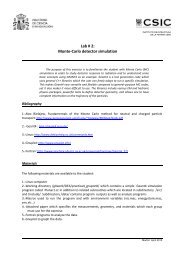Ri<strong>de</strong>al mechanism, with a preference for reaction of the adsorbed atoms with gas phase D atoms. Concerning ions,the triatomic H 3 + , H 2 D + , HD 2 + and D 3 + , produced primarily in reactions of diatomic ions with molecules, aredominant.The kinetics in low pressure (0.8–8 Pa) p<strong>la</strong>smas of H 2 + 10% N 2 mixtures has been investigated too, using theformer diagnostic techniques. The data analysis with a kinetic mo<strong>de</strong>l has allowed i<strong>de</strong>ntifying the main mechanismsresponsible for the observed distributions of neutrals and ions, and their evolution with pressure. The chemistry ofneutrals is dominated by NH 3 formation (up to 70% of remaining N 2 ) at the metallic walls of the reactor throughsuccessive hydrogenation of N and nitrogen containing radicals. Eley–Ri<strong>de</strong>al and Langmuir–Hinshelwoodmechanisms are nee<strong>de</strong>d to account for the observed NH 3 concentrations. The p<strong>la</strong>sma ionic composition, entirely dueto gas-phase processes, results from a competition between direct electron impact ionization, which <strong>de</strong>pends onelectron temperatures, and ion–molecule chemistry. At 0.8 Pa, H 3 + , N 2 H + and NH 4+produced from protonation ofthe precursor molecules, and H 2 + and NH 3 + , coming from direct ionization, are found in comparable amounts. At 8Pa, collisions of H 3 + , NH 3 + and N 2 H + with NH 3 are to a great extent responsible for the final prevalence of NH 4 + .Besi<strong>de</strong>s, an overview of the main chemical processes which take p<strong>la</strong>ce in cold p<strong>la</strong>smas generated in glowdischarges, both in the gas phase and at the surfaces in contact with the p<strong>la</strong>sma has been done. Illustrative exampleshave been provi<strong>de</strong>d. Most common p<strong>la</strong>sma characterization techniques have been also briefly reviewed.Dynamics and kinetics of chemical reactions and <strong>la</strong>ser induced processesThe study of the the dynamics of proton (or <strong>de</strong>uteron) exchange D + + H 2 and H + + D 2 reactions has been pursuedwith special emphasis on the simu<strong>la</strong>tion of the whole set of measurements on cross sections and rate coefficientsgathered for these systems since the eighties. The results of this comprehensive comparison will be presented in thenear future. Rate coefficients for the mass extreme isotopologues of the H+H 2 reaction, namely Mu+H 2 and Heμ+H 2 , where Mu is muonium and Heμ is is a He atom in which one of the electrons has been rep<strong>la</strong>ced by a negativemuon, have been calcu<strong>la</strong>ted using both accurate quantum mechnical (QM) and quasic<strong>la</strong>ssical trajectory (QCT)methods and compared to recent experimental measurements and to calcu<strong>la</strong>tions by Fleming et al. (Science 331,448, 20211). The QCT method can reproduce reasonably well the observations if the trajectories are weighted with aGaussian function favoring their proximity to the right quantal vibrational action. The analysis of the results showsthat the <strong>la</strong>rge zero point energy of the MuH product is the key factor in the <strong>la</strong>rge kinetic isotope effect observed.These works have been carried out within the framework of our “Unidad Asociada <strong>de</strong> Química Física Molecu<strong>la</strong>r”,which inclu<strong>de</strong>s groups from the “Universidad Complutense” and the “<strong>Instituto</strong> <strong>de</strong> Química Física Rocaso<strong>la</strong>no”.Laser induced processes have also been investigated in the context of this col<strong>la</strong>boration. The generation of highor<strong>de</strong>r armonics from metal p<strong>la</strong>smas was studied using 1 kHz <strong>la</strong>ser pulses. The dynamics of the H atom transferreaction in the photodissociation of pyrrole-ammonia clusters was investigated using the technique of velocity mapimaging. The results were found to favor a mechanism based on the direct NH bond rupture. A combine<strong>de</strong>xperimental (slice imaging) and theoretical (multisurface wave packet) study of the 304 nm photodissociatoion ofCH 3 I was also carried out. The analysis of the results evinced a concurrence of adiabatic and non-adiabatic channelsin the dissociation process.More <strong>de</strong>tails about this line of research and the researchers and supporting personnel that work in it, can be found inour webpage: http://www.iem.cfmac.csic.es/<strong>de</strong>partamentos/fismol/fmap/main.htmMOLECULAR FLUID DYNAMICSThe main goal of this research line is the study of fluid flows in the interphase between the microscopic<strong>de</strong>scription,essentially molecu<strong>la</strong>r and quantum, and the macroscopic one, governed by the continuum fluidmechanics. Althoughboth limits are well <strong>de</strong>veloped as in<strong>de</strong>pen<strong>de</strong>nt fields, their link is a sort of no-man's <strong>la</strong>nd<strong>la</strong>cking experimental data,sufficiently rigorous theoretical mo<strong>de</strong>ls, and efficient calcu<strong>la</strong>tion methods. From the experimental point of view,un<strong>de</strong>rcooled liquid jets are an i<strong>de</strong>al medium for studying the homogeneous solidification, free from container walleffects orimpurities. On the other hand, supersonicgas jets are a very fruitful research media, where the study ofine<strong>la</strong>stic collisions, the fundamental mechanism ofenergy transfer between molecules, can be affor<strong>de</strong>d.Along the <strong>la</strong>st eighteen years, we have built at the Laboratory of Molecu<strong>la</strong>r Fluid Dynamics twocompleteinstruments for jet diagnostics, whose performance and flexibility are unique worldwi<strong>de</strong>. One of them (A)is <strong>de</strong>voted to the study of cohesive collisions and liquid jets, and the other one (B) to ine<strong>la</strong>stic collisions. Someimprovements have been carried out along <strong>2011</strong> on these instruments to suit the experiments. In this regard, a newsystem of three motorized microactuators to move the nozzle along an arbitrarily tilted path, with a resolution betterthan 100 nm, has been installed on instrument (A). This is of great help for the Raman spectroscopic study ofun<strong>de</strong>rcooled liquid microfi<strong>la</strong>ments produced from g<strong>la</strong>ss capil<strong>la</strong>ry nozzles cooled by liquid He, which are rarelycollinear with the nozzle. On the other hand, we have acquired a special vacuum group for instrument (B), to pump68
pure oxygen from stagnation pressuresabout 10 times higher (~ 2 bar); with these pumps we expect the jet to reachrotational temperatures between 4 and 10 K, as well as to observe the formation of dimers and small O 2 clusters. Wehave purchased and installed a new controlled evaporator-mixer to produce jets of gaseous mixtures of H 2 O dilutedin He or H 2 , since their collisions, of astrophysical interest, are the subject of current research projects.We have also built an ortho-para hydrogencatalytic converter, improving an original <strong>de</strong>sign from the Max-P<strong>la</strong>nck-Institut für Strömungsforschung in Göttingen (Germany). This new converter can operate with steady flow rates upto 5.4 g/hour, yielding less than 0.4% residual ortho-H 2 . Such a high purity is critical for the experiments oncon<strong>de</strong>nsation, since small amounts of impurities can significantly affect the nucleation rate. A second"uncatalyzed"line through the convertercan beused as a cryogenic trap for preparation of mixtures. It must bestressed that much of the necessary high precision parts have been machined in the Mechanical Workshop ofCFMAC, whose support hasbeen essential. Our <strong>la</strong>boratory has now two converters, which allowed conducting theexperiments on mixtures of para-H 2 and ortho-D 2 <strong>de</strong>scribed below.Liquid microjets (fi<strong>la</strong>ments) of para-H 2 and ortho-D 2 mixtures at 2%, 20% and 50% were produced on instrument(A), in a joint project with the University of Frankfurt (Germany). These fi<strong>la</strong>ments, 2 to 5 microns in diameter, arecooled by surface evaporation in vacuum, producing liquid samples highly un<strong>de</strong>rcooled below their melting point,until they solidify or break into droplets. Series of Raman spectra at different axial distances have been recor<strong>de</strong>d onthese fi<strong>la</strong>ments, monitored by <strong>la</strong>ser shadowgraphy, allowing us to track the crystallization with a time resolution of ~10 ns. It was found that small amounts of ortho-D 2 impurity <strong>de</strong><strong>la</strong>ys significantly the crystallization rate of para-H 2 , aquantum effect not previously observed.On instrument (B) we have measured series of supersonic jets of pure H 2 O from a 350 micron nozzle at stagnationtemperature T0 = 398 K and pressures from p0 = 40 mbar to 400 mbar, in or<strong>de</strong>r to study the H 2 O:H 2 O ine<strong>la</strong>sticcollisions. These measurements eventually showed that H 2 O con<strong>de</strong>nsation is always present for p0> 40 mbar,disturbing the thermal evolution of the jet and preventing the quantitative analysis of collisional kinetics. We havealso measured con<strong>de</strong>nsation-free mixtures of 5% H 2 O in He, reaching rotational temperatures of 36 K, the lowest sofar. These experiments are expected to yield valuable quantitative information onthe H 2 O:He collisions. To thisregard, some preliminary values of transfer rates by H 2 O:He ine<strong>la</strong>stic collisions have been calcu<strong>la</strong>ted by the group ofTheoretical Molecu<strong>la</strong>r Interactions and Dynamics of the<strong>Instituto</strong> <strong>de</strong> Física Fundamental CSIC, which works in closecol<strong>la</strong>boration with us.In the methodology section, we have confirmed the ina<strong>de</strong>quacy of current mo<strong>de</strong>ls (based on the isentropicapproximation of an i<strong>de</strong>al gas) for an accurate <strong>de</strong>scription of the fluid dynamics of supersonic jets. Therefore, wehave <strong>de</strong>veloped "ex novo" a fluid dynamics theory, based on the rigorous physical principles of mass, momentumand energy conservation, treating the expanding gas as a real gas, with no i<strong>de</strong>alization. This treatment can bridgefrom continuum mechanics to quantum mechanics in a rigorous way, and <strong>de</strong>scribes the gas media at the molecu<strong>la</strong>rlevel more a<strong>de</strong>quately than through the intractable generalized Boltzmann equation. The theory reveals twodominant regimes in the jets, <strong>de</strong>pending on whether the transfer of energy by ine<strong>la</strong>stic collisions is "easy" or"difficult". The resulting fluid dynamic equations allow to interpret in a natural way the gradual breakdown ofthermal equilibrium along the jet, quantifying its properties in terms of collisions through the novel concept of gasdynamicheat capacity, which only at equilibrium converges into the conventional one. The <strong>de</strong>veloped theory alsoshows unambiguously that supersonic jets are not isentropic, although this approach may be useful un<strong>de</strong>r certainconditions, which are now clearly <strong>de</strong>fined.69
- Page 3:
INTRODUCCIÓNEl Instituto de Estruc
- Page 10 and 11:
Dra. Maria Esperanza Cagiao Escohot
- Page 12 and 13:
TALLER ÓPTICOD. José Lasvignes Pa
- Page 14 and 15:
2A.1 DPTO. DEQUÍMICA YFÍSICA TEÓ
- Page 16:
empezar a caer. Este fenómeno se e
- Page 19 and 20: Existen varias diferencias entre la
- Page 21 and 22: Estudio de las propiedades estructu
- Page 23 and 24: poblar los estados de interés en 1
- Page 25 and 26: Si bien la técnica TF está bien e
- Page 27 and 28: que no se produzca la ruptura de en
- Page 30 and 31: antitumoral emodina mediante el efe
- Page 32 and 33: Esta formulación ha sido desarroll
- Page 34 and 35: oooooCriogenia.Espectroscopía Rama
- Page 36 and 37: FLUIDODINÁMICA MOLECULAREl princip
- Page 38 and 39: También se ha concluido y publicad
- Page 40 and 41: o Análisis mecánico en tracción:
- Page 42 and 43: cuerpo (BCC), tiene lugar la formac
- Page 44 and 45: BIOSAXSCaracterización de coloides
- Page 46 and 47: Sin embargo, desde el punto de vist
- Page 48 and 49: 2B.1 THEORETICAL PHYSICS AND CHEMIS
- Page 50 and 51: terms and that b) stellar pulsation
- Page 52 and 53: We have investigated transport thro
- Page 54 and 55: een proposed as possible interstell
- Page 56 and 57: The figure shows a compilation of t
- Page 58 and 59: oppositely aligned spins. This pair
- Page 60 and 61: PHYSICAL BEHAVIOR AT NANO-SCALESPro
- Page 62 and 63: done in collaboration with research
- Page 64 and 65: Finally, we have also conducted a w
- Page 66 and 67: species have been obtained from tim
- Page 70 and 71: Liquid hydrogen filament (5 micron
- Page 72 and 73: Nanostructure of polymer thin films
- Page 74 and 75: morphological model for Natural Rub
- Page 76 and 77: product. The clay can be used direc
- Page 78 and 79: with the extracellular ERBBs domain
- Page 80 and 81: 3.1 DPTO. DEQUÍMICA YFÍSICA TEÓR
- Page 82 and 83: Duration: January 2010-December 201
- Page 84 and 85: Objectives: This Project aims at ob
- Page 86 and 87: Funding Institution: Comunidad de M
- Page 89 and 90: CAPÍTULO 4COOPERACIÓN CIENTÍFICA
- Page 91 and 92: 4.1.3 DPTO. DE FÍSICA MOLECULAR /
- Page 93 and 94: o Complete Hybrid Quantization of a
- Page 95 and 96: R3B Collaboration Meeting, Darmstad
- Page 97 and 98: SERS Roundtable 2011, Poltersdorf (
- Page 99 and 100: International Conference on Process
- Page 101 and 102: 4.3. ESTANCIAS DE INVESTIGADORES EN
- Page 103 and 104: Dr. Francesca Vidotto.Université d
- Page 105 and 106: 4.4.3 DPTO. DE FÍSICA MOLECULAR /
- Page 107: Guillermo Ribeiro Jiménez. Subatom
- Page 110 and 111: 5.1 DOCENCIA / TEACHING5.1.1 DPTO.
- Page 112 and 113: 5.1.3 DPTO. DE FÍSICA MOLECULAR /
- Page 114 and 115: 5.2.3 DPTO. DE FÍSICA MOLECULAR /
- Page 116 and 117: Óscar Gálvezo Hielos y Plasmas de
- Page 118 and 119:
Olof Tengblad- Deputy Technical Man
- Page 120 and 121:
5.5 ACTIVIDADES Y MATERIAL DE DIVUL
- Page 122 and 123:
Plasma, el cuarto estado de la mate
- Page 124 and 125:
5.7 UNIDADES ASOCIADAS Y OTRAS ACTI
- Page 126 and 127:
oScientific collaboration on “Din
- Page 128 and 129:
6.1 PUBLICACIONES EN REVISTAS Y PRO
- Page 130 and 131:
Prescriptions in Loop Quantum Cosmo
- Page 132 and 133:
Richardson-Gaudin Models: The Hyper
- Page 134 and 135:
79. L. Guerrini, S. Sanchez-Cortes,
- Page 136 and 137:
Probing the Nature of Particle-Core
- Page 138 and 139:
PROCEEDINGS ISI /ISI PROCEEDINGS120
- Page 140 and 141:
Physical Review Letters 106, 245301
- Page 142 and 143:
Conducting Nanocomposites Based on
- Page 144 and 145:
3. O. S. Kirsebom, S. Hyldegaard, M
- Page 146 and 147:
6.4 TESIS DOCTORALES / Ph. D. THESE
- Page 149 and 150:
CAPÍTULO 7TABLAS Y DATOSCHAPTER 7T
- Page 151 and 152:
Spectrochimica Acta B 2 3.552Chemph
- Page 153 and 154:
7.4 PERSONAL POR DEPARTAMENTOS /PER
- Page 155 and 156:
ÍNDICEINDEX155
- Page 157 and 158:
4.1.2 Dpto. de Espectroscopía Nucl
- Page 159:
6.2.2 Dpto. de Espectroscopía Nucl


